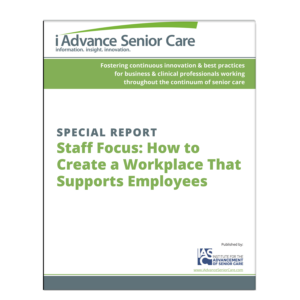Hiring and Keeping the Best People
| BY LETA BEAM |
| Hiring and keeping the best people Create a talent plan to reenergize and refocus your crew |
| It seems as though we never stop talking about or focusing on shortages, and that’s particularly true about staffing our facilities. Nursing shortages. CNA shortages. We’ve become resigned to the notion that these shortages are apparently perennial and will probably never go away. Could it be, though, that these shortages can be solved by questioning our everyday assumptions and trying a different approach? No question about it: One of our most urgent business challenges is finding, cultivating, and keeping extraordinary talent. Sometimes we kid ourselves that “good people” don’t exist. There are lots of good people out there, and they probably already have pretty good work experiences. It is our responsibility to clearly identify exactly who we are looking for and come up with more creative ways to find them. It’s also up to us to establish a culture and an environment that distinguishes our organization from others so that we can attract those talented people and make them want to stay. The question, then, is: How can we change our work culture to attract, grow, evaluate, reward, and retain the best in the business? If you think you’ve already heard more about culture change than you’ve wanted to hear, consider the following statistics about organizations in general:
You can increase your ability to attract top talent by creating a talent plan, a comprehensive road map for attracting great people, growing them, and allowing them to create their own legacies within your organization. For most of us, creating a talent plan requires us to regain and redirect our energy and focus, and replace “same old, same old” habits in hiring and retention with a new set of thoughts, feelings, beliefs, and actions. Talent planning touches everyone at every level, from the board of directors/top administration on down, thus promoting a strong sense of “we.” Everyone should share information with one another, and leaders should make themselves accessible. Keep in mind that talent planning is not a program, it is a mind-set. It is not a magic bullet, but rather an ongoing, lasting way of working that will take a year or longer to create. At the heart of the successful talent plan is the vivid vision of creating leaders at all levels within the organization. That vision comes alive along two distinct but related tracks: 1. Assisting everyone (all staff) to grow their personal abilities to lead within their own area of expertise. It involves learning and unlearning, challenging autopilot thinking and acting, and getting rid of an overblown fear of regulations and surveys. Staff are introduced to the power of intentional thinking, get permission to develop and “own” solutions and, in the process, build self-esteem. 2. Assisting a smaller group of “influencers” (today’s management team and those with potential for bigger roles) to lead in an even bigger, broader context. Your management team will not only want to grow their own personal abilities, but refine other skills, as well, including:
The following are three illustrations of talent-planning approaches using these principles. Conduct business huddles. Adopt this next-generation version of the stand-up meeting. Anyone can call a huddle in any place (hallways, too), and they’re quick, laser-focused, inclusive, and solution-oriented. Hospital physicians have long practiced this and have a great name for it: “corridor consults.” Reassess the Welcome Program for new staff. Retention attention must begin immediately. The first 90 days are critical to the development of patterns for good working relationships. We need to put an end to the “we eat our young” mentality and create a rich mentoring program that intentionally teams new employees with what I call organizational ambassadors. If these new team members are indeed special, then treat them that way. Remember that the single biggest influence in encouraging top talent is credible, accessible leadership. Recognize that little things matter. The LTC industry is heavily regulated. But that doesn’t mean that there aren’t hundreds of ways to regularly dial up the quality of work life at your facility. Here are a few of the ideas that colleagues have shared over time:
These are a few examples of talent planning maneuvers that will produce significant results over time. Right now, few of us have a waiting list of eager applicants. But that could change. We only have to work at it. And with time and an increasingly talented staff, maybe we won’t need so many applicants. Leta Beam, an executive with more than 20 years of business experience, is a leadership and business coach, and President of Vantage International. For more information, call (717) 238-3939 or visit www.vantage-inter.com. To send your comments to the author and editors, e-mail beam0106@nursinghomesmagazine.com. To order reprints in quantities of 100 or more, call (866) 377-6454. |
I Advance Senior Care is the industry-leading source for practical, in-depth, business-building, and resident care information for owners, executives, administrators, and directors of nursing at assisted living communities, skilled nursing facilities, post-acute facilities, and continuing care retirement communities. The I Advance Senior Care editorial team and industry experts provide market analysis, strategic direction, policy commentary, clinical best-practices, business management, and technology breakthroughs.
I Advance Senior Care is part of the Institute for the Advancement of Senior Care and published by Plain-English Health Care.
Related Articles
Topics: Articles , Staffing











